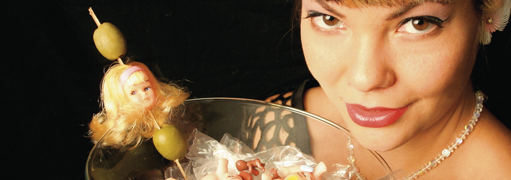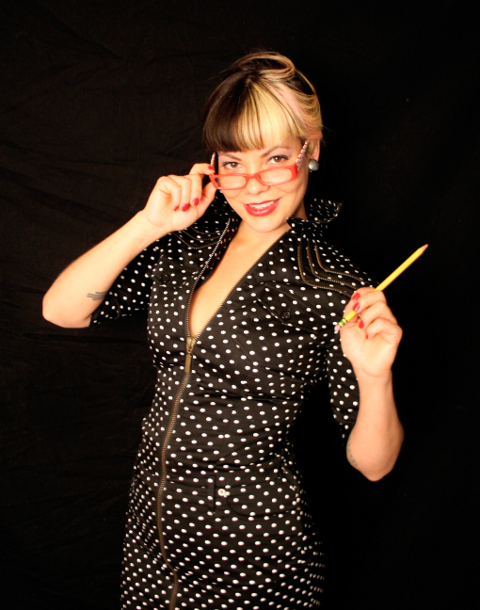“People in New Mexico are organically vintage. Everybody has a strong connection to their grandparents. Everybody has a project car. … Go to these small towns. They are so full of story. They are teeming with so much culture,” Ungelbah Davila said. “I’m committed to not letting us become homogenized into what the rest of the country is. If we lose this, we lose our place in the world.”Ungelbah Davila sat coolly at her desk in EFG Creative—chic in heels, a pencil skirt and tattoos that call to mind her own pinup photography—and spoke excitedly about the opportunity to tell great stories. The owner, editor and mastermind behind La Loca Magazine is a story in her own right.“I grew up in Catron [County, N.M.],” Davila, whose friends call her Ungie, said. “There’s, like, one caution light in the whole county. The older I get, the stronger my love for ranching life [becomes].”Davila now resides in Albuquerque, but she spent most of her childhood in small-town, rural New Mexico. From a Navajo background, she was invested in her culture and in the community around her. She describes her family as hardcore “off-the-grid livers.” “We did not have electricity,” she said. “Running water, yes, but no electricity.”And she spent much of her time with her grandmother.“In my small town, our small community, our lawn ornaments were Model Ts,” the young entrepreneur said. “I grew up in a very antiquated setting and began to love antiquity.” Davila adores antiquity and ephemera so much, in fact, that her taste for all things vintage—pinup girls, hot rods and the like—has remained strong throughout her life’s twists and turns. Moving about the state, Davila developed a knack for using media to tell stories. Growing up in Catron, young Ungie wrote fiction; in high school, she became interested in documentary and then photography. Davila now works as a professional photographer for Pinup-ology, when not busy with writing and editing for La Loca.“I have a short attention span,” Davila said of her use of various media. “I am the owner, editor and primary photographer for the magazine—a bit of a one-woman show. I specialize in—but am not limited to—pinup and boudoir photography, both when I am and am not busy with the magazine. My formal education is in creative writing. At the end of the day, I am a storyteller, whatever the medium.”Davila combined her talents and passions in the conception and execution of La Loca, and she began publishing online three years ago while still in college. The publication proudly boasts it is “New Mexico’s first female, Native-owned vintage lifestyle and alternative arts publication.” Its content is “uniquely New Mexican with Spanish, Native and hillbilly rolled into a one-of-a-kind enchilada!”Davila described the publication as initially “rockabilly,” a musical, fashion and cultural form that described the lifestyle she’d always led and loved. “I didn’t know what the term ‘rockabilly’ was until I was 21 or 22,” she said. “I always kind of felt like an outcast, until I found rockabilly.”Popular in California, rockabilly originated as a musical combo of classic rock and country. And it hasn’t strayed far since. It continues to highlight ’50s trends like pinup girls and hot rods, incorporating modernist elements like tattoos. It is a space where urban and electric meets earthy and country-western in a way that—while classic—is just gaining ground in our state.Still, Davila said it is not difficult to have an appreciation for rockabilly in a place like the Land of Enchantment, where vintage and simple is often effortless and common. She aims to tell stories of the “working man of New Mexico, the person [who is] not going to show up in mainstream media.”“I want to fill a void we have in media,” Davila said. “[New Mexican towns] are so full of story. They are a wealth. There is the story of the guy at the gas station or the town muralist who paints just because he wants to. There are the stories of our elders.”While delving into small-town New Mexico life, La Loca also has an edge. With its pinup and boudoir themes and its humble beginnings, Davila said the publication is “meant to be fabulous … and a little ballsy.”Among other things, Davila hopes to highlight small towns, gain ground in the state and expose New Mexico to an audacious culture it may not be accustomed to. “I hope for my audience to discover something new, to appreciate all the wonderful lowbrow art and eclectic culture that gives New Mexico and its people such a strong identity and pride of place and heritage,” Davila said. “I hope to convey the point that New Mexico is more than hot air balloons, turquoise and casinos—as wonderful as those things are and not to discredit their value by any means. [But] I want to tell the stories of our people, collectively and as individuals.”







